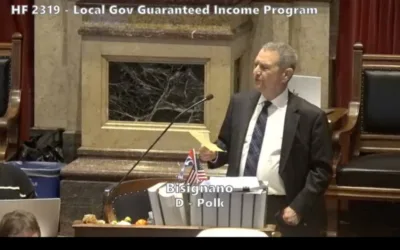
If Gov. Kim Reynolds’ goal was to make it impossible for public schools to shut down in the midst of a deadly pandemic, it’s hard to imagine a better strategy for doing so than the one they’ve laid out.
Concerned parents and educators’ anger has been rising for weeks over the state’s slapdash school reopening plan, with a major point of frustration centering around the threshold for allowing schools go to online-only. It’s a near-impossible situation to obtain, even as Iowa’s coronavirus crisis worsens. A school district’s county or counties must experience an average of 15% positivity in case/testing for two weeks’ time, as well as seeing absenteeism of at least 10% in that same time.
As we discussed earlier this week, the positivity rate (number of positive cases divided by tests administered) is flawed for many reasons. And even then, the U.S. Surgeon General suggests a threshold of 10% positivity, while many health experts prefer a 5% number for reopenings.
So, how did Iowa end up with the high 15% number in the first place?
Dr. Caitlin Pedati seemed to give away a major clue during the governor’s Tuesday press conference in a comment that largely went unnoticed.
[inline-ad id=”4″]
When Reynolds was questioned by a reporter on the reasoning behind the metric, the governor tossed it to Pedati.
“Looking at some of our communities that have smaller populations and trying to keep in mind how those percentages translate into numbers when there are smaller groups of people, smaller communities, as well as other things going on in a community,” Pedati said after saying they were striving for balance. “For example, other people who might be affected in other settings, like longterm cares or other congregate settings. So, we want to take all of that into consideration when we use something like a percent positivity.”
While Pedati’s lengthy, meandering answers can sometimes lack meaningful content, this response seemed to reveal a lot.
What it appears that she was saying is that IDPH and Reynolds considered how an otherwise small jump in positive cases in a rural county can easily produce a high positivity rate. It’s much easier for a 20-person outbreak among friends, family, coworkers or a living space to cause a noticeable percentage jump in both positivity and per capita rates in a place like Ringgold County than somewhere like Polk County.
[inline-ad id=”1″]
But it’s even more likely when an outbreak happens in “longterm cares or other congregate settings.” So, an outbreak in a nursing home, a packing plant or manufacturing plant, a prison or other close-quarters setting can very quickly spike numbers in a rural county, as we’ve seen over and over again in the past five months.
On the one hand, you can sort of see the logic they were going for with this. If 30 residents suddenly get sick at a nursing home in a town of 5,000, you may be less at risk if you go to a local restaurant than if 30 people from all walks of life were to get infected in town. It’s not like most people are going to come into contact with the nursing home residents, whereas were it 30 completely random people in town, who knows.
What IDPH and Reynolds seems to be angling for is they want to reduce the chances that a “congregate setting” outbreak triggers school shutdowns, which they see as different than “community spread.” And because a plant or nursing home outbreak can — in their eyes — skew the real “community spread” number, they had to set the threshold at a ridiculously high number to avoid it happening much.
[inline-ad id=”3″]
That, of course, ignores the obvious problem that congregate setting outbreaks are not solely confined to those places. How do you think nursing home outbreaks happen in the first place? A worker who lives out in “the community” gets infected and spreads it at the facility. Plant outbreaks cause very serious community spread, and many workers are the parents of the kids soon heading off to school. Reynolds tried to handwave off the Fort Dodge prison outbreak as “completely contained” even as she noted that 32 staffers were infected.
It also continues the callous, dismissive attitude of Reynolds and IDPH toward nursing home outbreaks as part of some separate problem, as if they too are not an important, loved part of the community. Or, as Pedati seemed to frame it, “other things going on in a community.”
Regardless, all this also has very serious consequences for more urban counties. The 15% threshold is an exceptionally high bar to cross, particularly in larger cities where there’s more widespread testing operations set up. By basing the threshold off of the situations in smaller, rural counties, Iowa is making things more dangerous for the urban centers.
The problem that Iowa is about to experience is the new “congregate setting” that will become a hotspot is the schools themselves.
[inline-ad id=”2″]
At the end of the day, none of it may matter.
Iowa’s outbreak is so bad that some counties do already cross the 15% threshold. As of Sunday afternoon, eight counties are at 15% or higher: Webster, Humboldt, Clarke, Lucas, Shelby, Emmet, Franklin and Wright. Reynolds, however, indicated earlier this week that she’ll easily dismiss and ignore the numbers she and IDPH put out when counties hit those marks, using “community context” to deny closures.
“And again I would emphasize that this is a place we need to be flexible and it’s a place where we’re going to continue to evolve as new information and new guidance and new science emerges,” Pedati added in her Tuesday answer. Flexibility during the Reynolds administration in the pandemic has almost always meant less safety precautions, not more.
[signup_form]
Still, it’s important to realize how the decision-making is being conducted behind the scenes, and whose lives they are prioritizing — or, in nearly every case, de-prioritizing. The goal here from Reynolds and IDPH is to keep Iowa life going as normally as possible, everywhere, no matter the dire health consequences for actual Iowans or the impact on continued spread.
Which means we’re now in the situation where because Iowa couldn’t keep its oldest and most vulnerable residents safe in nursing homes, the state’s youngest will now be at greater risk.
by Pat Rynard
Posted 8/9/20
Iowa Starting Line is an independently-owned progressive news outlet devoted to providing unique, insightful coverage on Iowa news and politics. We need reader support to continue operating — please donate here. Follow us on Twitter and Facebook for more coverage.

Big corporations are suing to block Biden’s efforts to lower costs
From the cost of medication to education to everyday expenses, the Biden administration has passed several laws and implemented many federal rules...

Iowa Republicans make outlawing gay marriage key 2024 campaign priority
Iowa Republicans have made outlawing gay marriage a key goal in their 2024 party platform. During the Iowa GOP’s 2024 state convention on Saturday,...

Department of Justice says Iowa immigration law violates US Constitution
If Iowa doesn’t suspend the enforcement of its new immigration law by May 7, the state could face a federal lawsuit, according to the Des Moines...

Rushing: Iowa State president said the quiet part out loud
I want to thank Iowa State University President Wendy Wintersteen for doing us all a favor by finally saying the quiet part out loud: all the...

Iowa sets aside almost $180 million for year two of voucher program
Iowa has committed nearly $180 million in taxpayer funds to support private school tuition in the 2024-25 school year, which is almost $50 million...

Kalbach: Immediate action needed on corporate ag pollution
Iowa agriculture has undergone substantial changes over the past 40 years. We see it all around us. Rather than crops and livestock being raised on...





